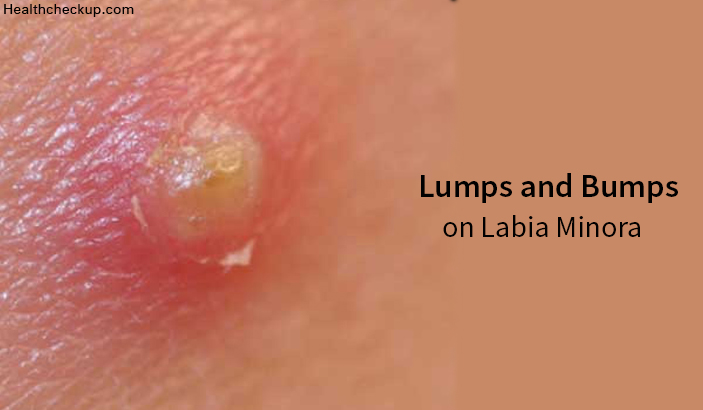At times, you might notice that the colour of your vagina is not normal, or it has lumps and bumps on it. This occurs in a number of women, and you need to get them treated. These are common during the childbearing years or may occur as you grow in age. In these cases, you should see a doctor. Well, Lump on Labia Minora can be caused due to a number of reasons.
First lets understand “what a Labia Minora is?”. When you are referring to the Vagina, its the internal organ and the vulva is the external genetalia of the vagina. The vulva includes the Labia Majora and Labia Minora. Labia Majora are the larger lips of your vulva. The outer side of the Labia Majora is where your find your pubic hair. If you pull the Labia Majora apart, you’ll see your Labia Minora, the smaller lips of the thin skin which surrounds the opening to your vagina.
Here are the Common Factors that Causes Lumps and Bumps on Labia Minora:
Vulvar Cysts
A number of glands are present in the vulva. In case these glands get clogged, it may result in a cyst. The cysts may vary in size, and they may feel like a small, hard lump. These are generally painless unless they get infected. These cysts may disappear without treatment, and if it gets infected, your doctor may prescribe antibiotics to get them cured.
Vaginal Cysts
Vaginal cysts can be of various types. You may feel a hard lump on the wall of the vagina. These cysts are about the size of a pea or smaller. Vaginal inclusion cysts are most common in women and they may form after the vagina suffers an injury, or after childbirth. These cysts are not painful but may cause discomfiture during sex. These cysts need to be drained, or you need to undergo a surgery to remove them.
Fordyce Spots
Fordyce spots, also known as sebaceous glands, are yellow or white coloured bumps, small in size, that develops inside the vulva. Generally, these spots may show up during puberty, and their number keeps on rising, as you grow in age. These are painless and does not cause much concern.
Varicosities
These are swollen veins around the vulva, occurring with aging. They occur in 10% of the women during pregnancies and look like raised bumps, bluish in colour, or swollen round veins around the labia majora and minora. Although they may not cause pain, they may feel heavy and lead to itching or bleeding.
Ingrown Hair
Ingrown pubic hair can develop as a result of shaving, plucking or waxing. These result in a round, small bump in the region. At times, they may be painful or itchy. These bumps may have pus and the skin around these bumps become darker. You should not make any attempt to remove the ingrown hair on your own, as they might lead to infection. These bumps disappear without treatment most of the times. In case they become inflamed, you need to see a doctor.
Vaginal Skin Tags
Vaginal skin tags are protruding flaps of extra skin, small in size. These are harmless unless they get rubbed, which may lead to irritation. These skin tags can be removed through laser treatments or surgeries.
Lichen Sclerosus
This is an uncommon skin condition, mostly affecting women who go through menopause. These develop around the anus, on the vulva. The symptoms of lichen sclerosus include severe itching, bleeding or bruising, pain during urinating or sex. You may notice blisters, which may be filled with blood, or a thin, shiny skin can easily tear. White spots appear on the skin in the area, which can turn to patches of wrinkled, thin skin over time. These can be treated with ointment or corticosteroid cream. Women who have lichen sclerosus have increased risk of cancer in the vulva.
Genital Herpes
Genital herpes is caused by the herpes simplex virus and the infection can be transferred through oral, anal or vaginal sex. The symptoms of genital herpes include flu, where you may have large sores, swollen glands, fever, pain in the genitals, legs or bottom. In the later stages, the symptoms include small ulcers, itching or tingling and multiple red bumps. It is advisable to visit your doctor to get them diagnosed.
Genital Warts
Genital warts are caused by the papillomavirus (HPV) and spread by anal and vaginal sex, and at times, through oral sex. The symptoms of these warts include burning, itching, closely packed warts forming rough patches and clusters of small bumps, with the colour of the skin. Genital warts can grow in the vagina, vulva or anus. The doctors prescribe creams, laser treatments or surgeries to eliminate these warts. If left untreated, it may lead to cervical cancer.
Cancer
Cancer in the vulva and vagina are rare, and their symptoms include the development of thick patches of skin, raised or flat bumps on the vulva, itching, pain, burning, sores and unusual discharge or bleeding. The colour of the skin in the area might be darker or lighter than the areas surrounding them. Cancer in the vulva may occur in the older women, or in the women who smoke. The level of risk is greater, in case you are infected by the HPV virus.
When Should you see the Doctor?
In case you have a painful lump in the vaginal region, you need to see a doctor. It is wise to consult the doctor when you are unaware of the changes taking place in your body. If the lumps do not disappear in a few weeks or show signs of infection, like blood or pus discharge, you should see the doctor. It is also necessary to see the doctor if you notice the symptoms of sexually transmitted diseases.
Often, vaginal lumps disappear without treatment. In case you go to the doctor, he/she will examine the cause and prescribes the necessary treatment. You can manage most of the vaginal lumps and bumps at home. In case you have cysts, you need to take warm baths a number of times a day and continue the process for a long time. This can help the cysts to drain. Avoid wearing clothes that rub your vulva. You need to wear clothes made of natural materials, such as cotton.
In most of the cases, the lumps on the vagina go away on their own and you can manage them at home. In case you have an STD, you need to consult the doctor for treatment. Perhaps, you have Bumps on Labia Minora, it is recommended to consult the doctor to eliminate the possible risks.
Medically Reviewed By

Maanasi specializes in health topics including diet and nutrition. A mother of an untiring seven year old, she enjoys nurturing her love affair with English. She is often found nestled with a book, plopped against a dozen pillows, smiling away at the brink of finishing yet another book of the many dozens, that adorn the shelves of her Mini Library!









